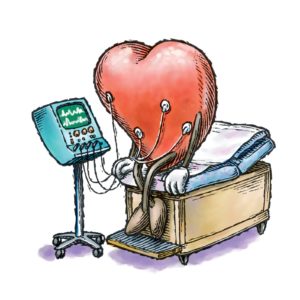We all have an amazing heart within our bodies. And this heart delivers an unique performance day in and day out. Your heart keeps you alive by ensuring oxygen is transported through your body to fuel the cells. And this is tough job.
Every minute 5.7 liters of blood (or 1.5 gallons) are pumped by the heart. That’s almost 8000 liter per day. And to achieve this the heart beats 100.000 times each day.
Our heart muscles are the most hard-working muscles we have and we can not train them really. These muscles never relax although the intensity of activity drops when we sleep.
The heart generates its own electricity and these electrical impulses flow through your heart in a pre-defined process ensuring the contraction and relaxation of the heart muscles and the opening and closing of the heart valves.
The blood which is pumped by the heart needs to reach all the blood vessels in your body. And this means all almost 100.000 km of these blood vessels.
This is done by a wonderful effective system of 4 heart chambers. 2 small chambers which store the incoming blood flow and 2 large chambers who are filled with the stored blood from the small chambers after which the muscle contraction ensures the blood if fierce fully pumped into the lungs or the other parts of your body. So the left and right side of your heart are different in purpose and a bit in structure. For instance the pressure in each of these chambers is different and this is an important issue for heart surgery.
Amazing complex heart system
In all its effectiveness the amazing heart is still a complex system. A lot can go wrong over time. Although heart tissue cells do not divided after a certain age their performance can deteriorate in terms of conduction. Like any other cell in our body heart tissue cells can change in their conduction performance. These conduction disorders can impact the triggering of the muscle contractions and this can be recognized as heart rhythm disturbances. Many heart diseases are related to these changes in conduction performance but often only recognized as arrhythmias when the disorder could have been identified earlier on.
The electrical generator of the heart can also be disturbed and this way our heart rate may be different from normal (high or low) but the heart tissue changes often influence the electrical processes and then we see heart rhythm irregularities or wors. And of course other problems within the heart can be related to changes which impact the closing or opening of the valves or the thickness of the heart walls. 
It’s a comforting thought human kind has learned so much over the amazing hearts, its performance, its internal structure and its pitfalls. It’s also comforting to know we are still learning how to improve diagnostics to identify problems as early as possible. The electrical system of the heart is one of the key factors and working with the diagnostic power of the Electrocardiogram is one of the best ways to improve both diagnostics and treatment support. There’s more to see in the ECG.






